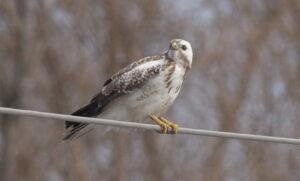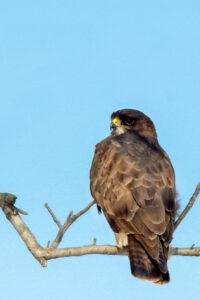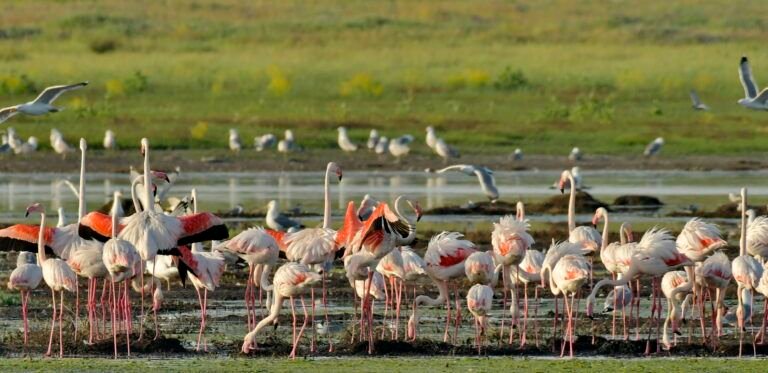The Common Buzzard (Buteo buteo) is a medium to large bird of prey, whose range covers most of Europe and extends into Asia. It is usually resident all year, except in the coldest parts of its range, and in the case of one subspecies.

The Common Buzzard measures between 40 and 58 cm (16 and 23 in) in length with a 109–136 cm (43–54 in) wingspan and a body mass of 427–1,364 g (0.94–3.01 lb), making it a medium-sized raptor.
This broad-winged raptor has a wide variety of plumages, and in Europe can be confused with the similar Rough-legged Buzzard (Buteo lagopus) and the only distantly related Honey Buzzard (Pernis apivorus), which mimics the Common Buzzard’s plumage for a degree of protection from Northern Goshawks. The plumage can vary in Britain from almost pure white to black, but is usually shades of brown, with a pale ‘necklace’ of feathers.
The Common Buzzard was first described by Linnaeus in his Systema naturae in 1758 as Falco buteo. Buzzard subspecies fall into two groups. The western Buteo group is mainly resident or short-distance migrants. They are:
- Buteo buteo buteo: most of Europe
- B. b. rothschildi: Azores
- B. b. insularum: Canary Islands
- B. b. arrigonii: Corsica and Sardinia
- B. b. menetriesi: Caucasus
- B. b. harterti: Madeira, doubtfully distinct from nominate Buteo

The eastern vulpinus group includes
- B. b. vulpinus (Steppe Buzzard): Eurasia: migrant breeder
- B. b. burmanicus (Himalayan Buzzard): Himalayas and western China
- B. b. japonicus: Japan: resident
- B. b. toyoshimai: Izu Islands and Bonin Islands
- B. b. oshiroi: Daito Islands
Two resident forms on islands close to Africa are often assigned to the first group, but appear to be distinct species, more closely related to the African Long-legged Buzzard, based on biogeography and preliminary mtDNA cytochrome b sequence data (Clouet & Wink 2000):
- Buteo bannermani (Cape Verde Buzzard): Cape Verde Islands
- Buteo socotraensis (Socotra Buzzard) of Socotra
The Common Buzzard breeds in woodlands, usually on the fringes, but favours hunting over open land. It eats mainly small mammals, and will come to carrion. A great opportunist, it adapts well to a varied diet of pheasant, rabbit, other small mammals to medium mammals, snakes and lizards, and can often be seen walking over recently ploughed fields looking for worms and insects. The birds have incredible strength and are therefore able to pick up food of all weights.
Buzzards do not normally form flocks, but several may be seen together on migration or in good habitat. The Victorian writer on Dartmoor, William Crossing, noted he had on occasions seen flocks of 15 or more at some places. Though a rare occurrence, as many as 20 buzzards can be spotted in one field area, approximately 30 metres apart, so cannot be classed as a flock in the general sense, consisting of birds without a mate or territory. They are fiercely territorial, and, though rare, fights do break out if one strays onto another pair’s territory, but dominant displays of aggression will normally see off the interloper. Pairs mate for life. To attract a mate (or impress his existing mate) the male performs a ritual aerial display before the beginning of spring. This spectacular display is known as ‘the roller coaster’. He will rise high up in the sky, to turn and plummet downward, in a spiral, twisting and turning as he comes down. He then rises immediately upward to repeat the exercise.
The call is a plaintive peea-ay, similar to a cat’s meow.
The Forest Buzzard, B. (b.) trizonatus, is another form sometimes upgraded to a full species, though most recent authorities have placed it as a subspecies of another species, the Mountain Buzzard, B. oreophilus. This is a resident breeding species in woodlands in southern and eastern South Africa.
It is very similar to the abundant summer migrant Steppe Buzzard, but the adult can be distinguished with a good view by its whiter underparts and unbarred flanks. The juvenile differs from the same-age steppe buzzard by its white front and tear-shaped flank streaks.
The Forest Buzzard, as its name implies, inhabits evergreen woodlands, including introduced eucalyptus and pines, whereas the steppe buzzard prefers more open habitats. However, habitat alone is not a good indicator for these forms.






